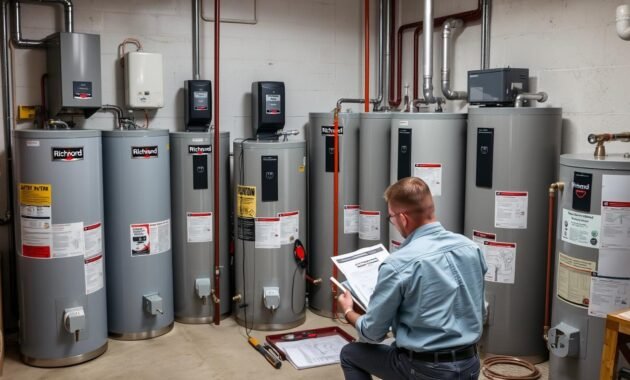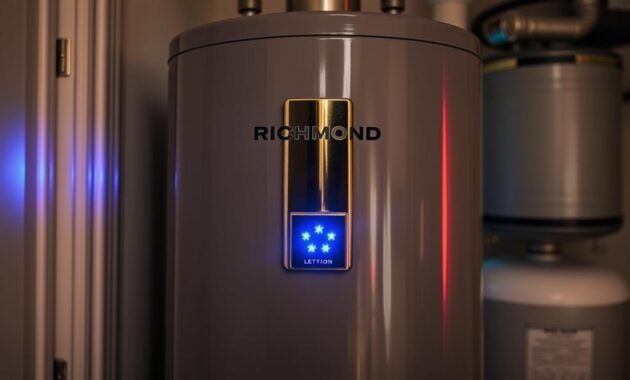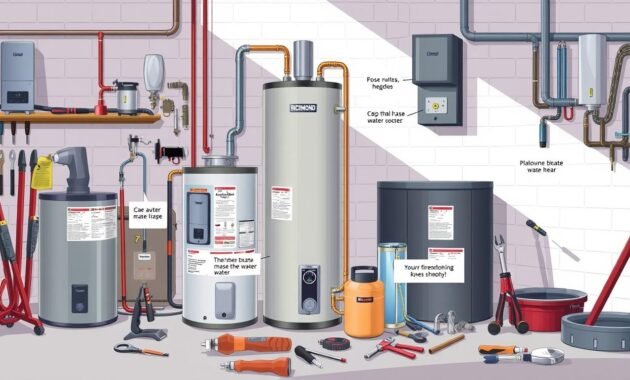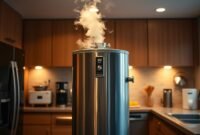Are you having trouble with your Richmond water heater? It can really upset your day. Issues like blinking lights or cold showers can lead to big repair costs if not fixed fast.
Many Richmond heater problems start small but get worse. The blinking lights on the control panel are like a secret message. Knowing what they mean can save you time and money, and avoid stress.
In this guide, I’ll show you how to fix common Richmond water heater problems. You’ll learn to handle issues like temperature changes, strange sounds, or system failures. This knowledge will help you tackle water heater problems confidently.
Read also: Blinking Light On Furnaces

Understanding Richmond Water Heater Components
Knowing how your Richmond water heater works is key to fixing it. I’ll explain the main parts to help you understand and fix your heater easily.
Richmond water heaters, made by Rheem, have many models for different homes. They offer everything from Essential to Encore, with advanced parts for steady hot water.
Essential Parts and Their Functions
- Thermostat: Regulates water temperature and monitors heating cycles
- Heating Elements: Convert electrical energy into heat for water warming
- Pressure Relief Valve: Prevents dangerous pressure build-up in the tank
- Anode Rod: Protects tank from corrosion and extends unit lifespan
Different Types of Richmond Water Heaters
Richmond offers various water heaters for different needs:
- Gas Water Heaters: 40-75 gallon capacities with efficient heating
- Electric Water Heaters: 50-80 gallon models with consistent performance
- Tankless Water Heaters: On-demand heating with compact design
- Hybrid Water Heaters: Energy-efficient models combining multiple technologies
Safety Features Overview
It’s important to know about safety and error codes for your Richmond water heater. Key features include high-temperature limit switches, automatic shut-off valves, and diagnostic error code systems. These help spot problems fast.
Learning about these parts and features will help you keep and fix your Richmond water heater well.
Common Signs of Water Heater Problems
Spotting issues with your Richmond water heater early can prevent expensive fixes and sudden failures. When I check water heaters, I look for certain signs that show your unit might need work.
Here are the main signs that mean you might need to fix your water heater:
- No hot water or not enough hot water
- Strange noises like rumbling or popping
- Discolored water with brown, yellow, or red colors
- Visible water leaks around the heater
- Inconsistent water temperature
Read also: Do the Water Leaking from under Bathtub?
When dealing with a Richmond pilot light or a heater that won’t heat, I suggest checking a few key things:
| Problem Area | Potential Cause | Recommended Action |
|---|---|---|
| Water Temperature | Sediment build-up | Drain and flush the tank annually |
| Pilot Light | Weak flame or no ignition | Check gas supply and clean burner |
| Water Color | Internal tank corrosion | Inspect anode rod and replace if needed |
Knowing these warning signs can help you fix water heater problems before they get worse. Regular upkeep and quick action to unusual signs can make your water heater last longer and keep hot water flowing.
Richmond Water Heater Troubleshooting
Dealing with water heater problems can be frustrating. But, knowing some basic maintenance tips can save you time and money. I’ll show you some key troubleshooting steps to help you find and fix common issues.
Basic Diagnostic Steps
Before you call a pro, try these quick checks to spot water heater problems:
- Check the power supply and ensure circuit breakers aren’t tripped
- Inspect the pilot light for consistent flame
- Verify thermostat settings
- Listen for unusual noises
- Check for water heater leaks around the unit
Using the Control Panel
The control panel is your main tool for troubleshooting. Most modern Richmond water heaters have digital displays. These displays show important info about how the unit is working.
- Look for any blinking lights or error codes
- Consult your user manual for specific code meanings
- Use the reset button if the system appears unresponsive
Understanding Error Codes
Error codes can quickly show you what’s wrong with your water heater. Here are some common ones:
| Error Code | Potential Issue | Recommended Action |
|---|---|---|
| E1 | Exhaust blockage | Check ventilation system |
| E5 | Overheating prevention | Verify temperature settings |
| E9 | Moisture in compartment | Inspect for water leaks |
While these steps can help, serious problems need a pro’s help. Regular maintenance and quick action to warning signs can make your water heater last longer and save you money on repairs.
Decoding Blinking Light Patterns
When you’re dealing with a Richmond gas heater or electric water heater, knowing the blinking light patterns is key. These lights tell you a lot about how your water heater is doing.

The LED indicator on your water heater is like a special tool. It uses blinking lights to share important info about its status. Each pattern can tell you if everything is okay or if there’s a problem.
LED Indicator Code Meanings
- No Flash: Pilot not lit or insufficient power
- 1 Flash: Normal operation
- 2 Flashes: Thermopile low voltage
- 4 Flashes: Temperature exceeded
- 5 Flashes: Sensor failure
- 7 Flashes: Gas control valve failure
- 8 Flashes: Power off failure
For electric heater troubleshooting, watch these patterns closely. A steady blink means everything’s fine. But rapid or odd blinking might mean something’s wrong.
Interpreting Blinking Sequences
| Blink Pattern | Potential Issue | Recommended Action |
|---|---|---|
| One blink, three-second pause | Failed ignition or unlit pilot | Check pilot light and gas supply |
| Two blinks, pause | Thermopile voltage problem | Inspect thermopile connections |
| Three blinks, pause | Exhaust temperature or pressure switch issue | Check venting and pressure switch |
| Four blinks, short pause | High water temperature | Verify thermostat settings |
If you see blinking patterns that don’t stop, it’s time to call a pro. Your safety and the health of your Richmond water heater are very important.
No Hot Water Issues and Solutions
Not having hot water can be really frustrating. To fix this, you need to follow a step-by-step guide. I’ll show you the most common problems that stop your hot water from working.
In Calgary, many homes face water heater problems. These can be due to power issues or broken parts.
Checking Power Supply
The first thing to do is check the power:
- Look at the circuit breaker for any tripped switches
- Make sure the water heater is plugged in right
- Try another device in the outlet
- Check the power cord for any damage
Thermostat Problems
Thermostat issues can really affect your hot water. Here’s how to check:
- Make sure the temperature is set right (120-140°F)
- Look for any damage on the thermostat
- Use a multimeter to test the thermostat
- If it’s broken, get a pro to replace it
Heating Element Issues
Electric water heaters have two heating elements. If one breaks, your water might not be hot:
| Symptom | Potential Cause | Recommended Action |
|---|---|---|
| Insufficient hot water | Faulty lower heating element | Professional replacement |
| No hot water | Both elements damaged | Complete element replacement |
| Intermittent heating | Loose electrical connections | Electrical system inspection |
For gas water heaters, make sure the pilot light is on. If you’re not sure, it’s best to call a pro to fix your water heater.
Dealing with Water Temperature Problems
Water temperature issues can be really annoying for homeowners. Knowing what causes them helps me fix them fast. Electric water heaters often face temperature problems for a few main reasons.
Sediment buildup is a big problem. It can block the tank and make heating less efficient. This leads to water that’s not hot enough. Regular maintenance can help avoid this.
- Check thermostat settings (typically between 90-120 degrees Fahrenheit)
- Inspect the drain valve for any blockages
- Flush the water heater every year to clear sediment
- Make sure the heating elements are working right
When I’m checking for temperature issues, I look at the thermostat and heating elements first. If they’re not working right, the water won’t heat up properly. This can make the water feel lukewarm or change temperature too much.
| Temperature Issue | Potential Cause | Recommended Action |
|---|---|---|
| Lukewarm Water | Sediment Buildup | Flush Water Heater |
| Inconsistent Temperatures | Thermostat Malfunction | Replace Thermostat |
| No Hot Water | Heating Element Failure | Replace Heating Element |
Regular maintenance can stop most water temperature problems. By knowing what common issues are, homeowners can make their water heaters last longer. This ensures they always have hot water when they need it.
Leak Detection and Resolution
Water heater leaks can quickly turn into a big problem. It’s important for homeowners to know how to find and fix leaks in Richmond water heaters. This helps keep your home safe and prevents big damage.
Common Leak Sources
Leaks in Richmond water heaters often come from a few main places. Here are the key ones to check:
- Tank bottom corrosion
- Loose drain valve connections
- Faulty pressure relief valve
- Sediment buildup
- Cracked water tank
Emergency Shutdown Procedures
Act fast when you see a water heater leak to avoid water damage. Here’s what to do:
- Turn off electrical power at circuit breaker
- Shut off cold water supply valve
- Drain the water heater tank
- Disconnect electrical connections
Preventive Measures
Regular maintenance can help avoid water heater problems. Here are some steps to take:
| Maintenance Action | Frequency | Purpose |
|---|---|---|
| Annual professional inspection | Yearly | Detect problems early |
| Flush sediment from tank | Every 6 months | Stop corrosion and keep efficiency |
| Check pressure relief valve | Quarterly | Make sure it works right |
Knowing how to spot leaks can help keep your Richmond water heater in good shape. This way, you can avoid water damage.
Maintenance Tips for Optimal Performance

Keeping your Richmond water heater in good shape is key to avoiding problems and keeping it running well for a long time. Regular checks can help spot issues early and avoid error codes.
Here’s how to keep your water heater running smoothly. These tips can save you money and make your unit last longer:
- Flush the tank every six months to remove sediment buildup
- Check and replace the anode rod every 3-5 years
- Inspect water connections for possible leaks
- Test the temperature pressure relief valve annually
Getting a professional to check your water heater can really help. Studies show that yearly inspections can stop up to 90% of breakdowns.
| Maintenance Task | Frequency | Estimated Cost |
|---|---|---|
| Tank Flushing | Every 6 months | $0 (DIY) |
| Anode Rod Replacement | Every 3-5 years | $22-$50 |
| Professional Inspection | Annually | $100-$200 |
Being energy smart is important too. Keeping your water heater at 120 degrees Fahrenheit and adding insulation can save up to 9% on energy costs. Simple steps like insulating pipes can reduce heat loss by 45%, saving you money.
Spending a bit of time on maintenance can save you a lot of money in the long run. Your water heater will be reliable and efficient, and it will thank you!
When to Replace Your Richmond Water Heater
Knowing when to replace your Richmond water heater can save you money and avoid sudden breakdowns. As a homeowner, I’ve found that timing is key. Spotting the right signs can help you decide when to replace your water heater.
Age Considerations for Replacement
Water heaters usually last 8 to 12 years. Keep an eye on your unit’s age. If it’s over 10 years old, it might be time for a new one. Important factors to consider include:
- Total years of service
- How often you maintain it
- The water quality in your area
- How well it was installed
Performance Indicators
Watch for these signs when trying to fix your water heater:
- Inconsistent water temperature
- Rust-colored water
- Frequent repairs
- Unusual noises from the tank
Cost Analysis of Replacement
When deciding to replace your Richmond water heater, consider the costs. Look at repair costs versus buying a new one. Here are some factors to think about:
| Replacement Factor | Estimated Cost Impact |
|---|---|
| Repair Costs | $300 – $500 per repair |
| New Energy-Efficient Unit | $800 – $1,500 |
| Annual Energy Savings | 10-15% on utility bills |
If you’re dealing with issues like a faulty pilot light or constant maintenance, getting a new water heater might be cheaper. New models are more energy-efficient and save money in the long run.
Conclusion
Exploring Richmond water heater troubleshooting has taught me the importance of proactive maintenance. A well-maintained Richmond water heater can last 13-15 years. But, understanding and addressing issues is key to its longevity.
Read also: AC Smith Water Heater
Getting a professional assessment is vital for your water heater’s health. They can help with sediment buildup, heating element checks, and temperature issues. This can save you from expensive replacements. I suggest annual maintenance to catch problems early and keep your water heater efficient.
Knowing your home’s hot water needs is essential. A 50-60 gallon tank is usually best for 3-4 person homes. Being aware of signs like popping noises, rusty water, or temperature issues can prevent big problems. Richmond heater troubleshooting can be simple with the right knowledge and quick action.
While DIY maintenance is good, some issues need a pro. If you’re unsure about complex problems, call an expert. Your safety and the life of your Richmond water heater are important.


